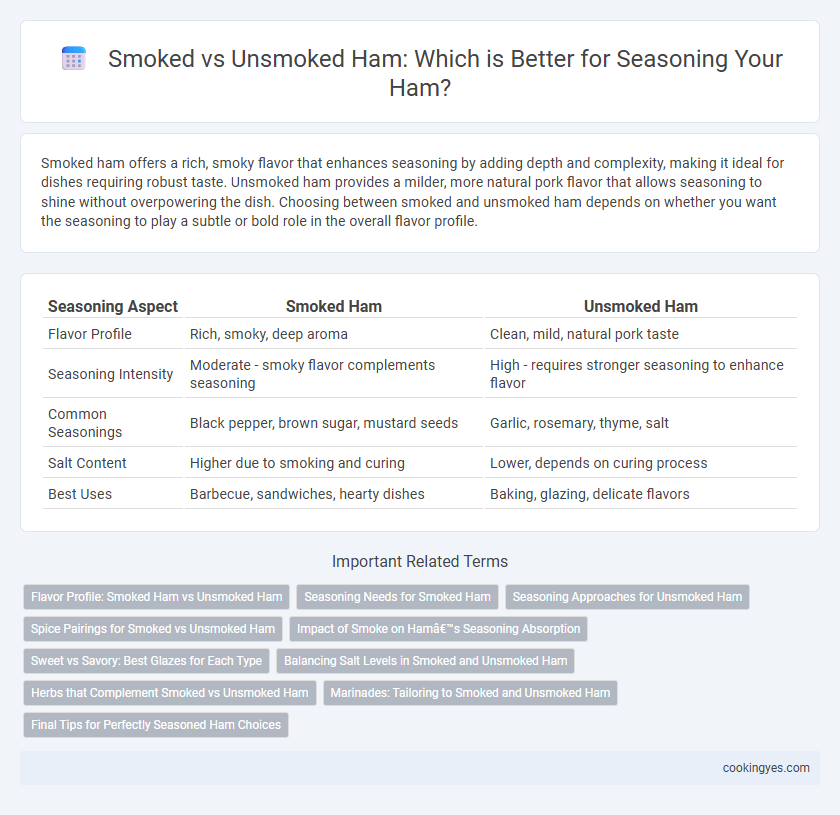Smoked ham offers a rich, smoky flavor that enhances seasoning by adding depth and complexity, making it ideal for dishes requiring robust taste. Unsmoked ham provides a milder, more natural pork flavor that allows seasoning to shine without overpowering the dish. Choosing between smoked and unsmoked ham depends on whether you want the seasoning to play a subtle or bold role in the overall flavor profile.
Table of Comparison
| Seasoning Aspect | Smoked Ham | Unsmoked Ham |
|---|---|---|
| Flavor Profile | Rich, smoky, deep aroma | Clean, mild, natural pork taste |
| Seasoning Intensity | Moderate - smoky flavor complements seasoning | High - requires stronger seasoning to enhance flavor |
| Common Seasonings | Black pepper, brown sugar, mustard seeds | Garlic, rosemary, thyme, salt |
| Salt Content | Higher due to smoking and curing | Lower, depends on curing process |
| Best Uses | Barbecue, sandwiches, hearty dishes | Baking, glazing, delicate flavors |
Flavor Profile: Smoked Ham vs Unsmoked Ham
Smoked ham offers a rich, smoky flavor with deep, savory notes created by exposure to wood smoke during curing, which infuses the meat with a distinct aroma and complexity. Unsmoked ham presents a milder, more delicate taste that highlights the natural pork flavor and allows seasonings like herbs, garlic, and spices to shine without competing with smoky undertones. Choosing between smoked and unsmoked ham depends on the desired seasoning balance; smoked ham pairs well with bold, complementary flavors, while unsmoked ham serves as a versatile canvas for diverse seasoning profiles.
Seasoning Needs for Smoked Ham
Smoked ham requires minimal seasoning due to its inherent smoky flavor profile, which is infused during the smoking process and imparts a rich, savory taste. The natural brine and smoke create a depth of flavor that often eliminates the need for heavy spices or additional salt. Light seasoning such as a sprinkle of brown sugar, honey glaze, or mild herbs enhances the smoked ham without overpowering its distinctive smoky character.
Seasoning Approaches for Unsmoked Ham
Unsmoked ham requires robust seasoning techniques to enhance its natural flavor, often involving brining with salt, sugar, and aromatic spices like cloves, garlic, and bay leaves. Dry rubs incorporating mustard powder, black pepper, and brown sugar create a flavorful crust during cooking, compensating for the absence of smoky notes. Marinating unsmoked ham in vinegar-based or fruit juice marinades intensifies moisture retention and adds depth to the palate.
Spice Pairings for Smoked vs Unsmoked Ham
Smoked ham pairs exceptionally well with robust spices such as cloves, mustard seeds, and black pepper, which complement its rich, smoky flavor. Unsmoked ham benefits from lighter, fresher seasonings like rosemary, thyme, and garlic that enhance its natural sweetness without overpowering it. Both types of ham can be seasoned with brown sugar or honey for a balanced savory-sweet profile, but the choice of spices should align with the ham's inherent taste characteristics.
Impact of Smoke on Ham’s Seasoning Absorption
Smoked ham undergoes a curing process infused with smoke particles that create a dense, flavorful outer layer, which can slow seasoning absorption compared to unsmoked ham. Unsmoked ham, lacking this smoke barrier, allows seasonings and marinades to penetrate more deeply and evenly, enhancing flavor complexity. The phenolic compounds and creosote in smoke chemically interact with the ham's surface, altering its porosity and impacting how seasonings bond to the meat.
Sweet vs Savory: Best Glazes for Each Type
Smoked ham's rich, savory flavor pairs exceptionally well with sweet glazes such as honey mustard, brown sugar, or maple syrup, enhancing its deep, smoky profile. Unsmoked ham, milder and more delicate, benefits from savory glazes featuring herbs, garlic, mustard, or balsamic vinegar, which complement its subtle saltiness without overpowering it. Choosing the right glaze balances sweet and savory notes, tailored to the ham's curing method for optimal taste.
Balancing Salt Levels in Smoked and Unsmoked Ham
Smoked ham typically contains higher salt levels due to the curing and smoking process, requiring careful seasoning to avoid overpowering flavors. Unsmoked ham has a milder, less salty profile, allowing for more flexibility with additional seasonings and herbs. Balancing salt levels ensures both smoked and unsmoked hams maintain optimal taste without excessive saltiness.
Herbs that Complement Smoked vs Unsmoked Ham
Smoked ham pairs well with robust herbs like rosemary, thyme, and sage, which enhance its smoky, savory flavor profile. Unsmoked ham benefits from lighter, fresher herbs such as parsley, tarragon, and chives, complementing its milder, sweeter taste. Using these herbs strategically elevates the overall seasoning, balancing and accentuating the distinct characteristics of each ham type.
Marinades: Tailoring to Smoked and Unsmoked Ham
Smoked ham benefits from marinades with robust, slightly sweet ingredients like maple syrup, brown sugar, and mustard to complement its rich, smoky flavor. In contrast, unsmoked ham pairs well with lighter, tangy marinades featuring citrus juices, apple cider vinegar, and fresh herbs to enhance its natural, mild taste. Adjusting marinade acidity and sweetness levels optimizes seasoning profiles for each ham type, ensuring balanced flavor absorption.
Final Tips for Perfectly Seasoned Ham Choices
Smoked ham offers a rich, smoky flavor that enhances seasoning blends with complementary spices like cloves, cinnamon, and mustard, creating a balanced and savory profile. Unsmoked ham provides a milder, cleaner palate, allowing for bolder herb and spice combinations without overwhelming the meat's natural taste. For perfectly seasoned ham, adjust salt levels carefully, consider the ham's inherent flavor intensity, and allow adequate marinating time to ensure deep seasoning penetration and optimal taste balance.
Smoked ham vs Unsmoked ham for seasoning Infographic

 cookingyes.com
cookingyes.com